:: Monday, October 18, 2004 ::
In August 2004, contributing editor EDUARDO NAVAS participated in a series of events at Centro, Laboratorio Arte Alameda, and the Rufino Tamayo Museum in Mexico City. Pursuant to his experiences, he returned to Los Angeles and has offerered his thoughts, review and summation of his involvement at this event. The series of five writings is presented this week as a single comprehensive feature to help offer the full effect of his critique.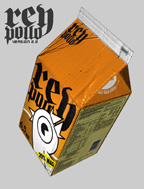 PART ONE
PART ONE
ORIGINAL POST: Tuesday, August 24, 2004
EXCERPT: I just returned from an amazing week in Mexico City. I was invited to participate in a series of events at Centro, Laboratorio Arte Alameda, and the Rufino Tamayo Museum. The air travel and stay of a set of international Latin American artists was funded by Centro, a brand new Media Center specializing in TV and Film, to inaugurate their new facilities. The curators of the events were Arcangel Constantini and Ivan Abreu.
I will be writing a set of articles that describe and comment on the different events, but for now I would like to provide a list of the participants since I will not be able to comment on all of their work in the more focused articles. People who participated in these important events include (in the order of the official list.)
click here to read the complete list of participants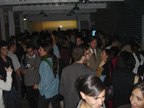 PART TWO
PART TWO
ORIGINAL POST: Monday, August 30, 2004
EXCERPT: In general, the sound compositions were dependent on loops so complex in their patterns that the audience was pushed to listen carefully and create relationships with the visual material, which for the most part was abstract, or if figurative, very open-ended for interpretation. It was more like digital noise, although the performances by Ivan Abreau and Brian Mackern referenced electronic dub and post-trip-hop sounds respectively. Abreu's performance was the most transparent of all because he showed his Max interface as he improvised his rhythms. The audience saw his real-time manipulation of sound. Mackern played a few short pieces that were quite soothing for the eyes and ears while strategically relying on noise to disrupt what at times could have been considered straight ahead ambient image and sound. Jorge Castro closed the evening with a short set of minimal compositions that were carefully complemented with visual material. He controlled sound and image simultaneously, and unlike much of the work throughout the night, which was mainly improvisational sessions between two or more performers, Castro presented music and visuals that had a predetermined relationship, yet he was able to improvise and flow with the reaction of the crowd. Unfortunately his set was too short, and the audience was left craving for more. No worries on this as he would have a chance to present his work once more at Laboratorio Arte Alameda, the evening after.
click here to read the second installment.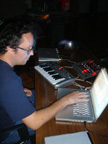 PART THREE
PART THREE
ORIGINAL POST: Friday, September 03, 2004
EXCERPT: The overall aesthetic was very consistent, regardless of the fact that some of these artists had never played together; yet the artists created abstract sounds and images that were slow to change while constantly relying on short visual and aural loops. The result was material open-ended for interpretation, overtly denying a specific meaning other than experiencing the process of creating the composition through improvisational collaborations. The performers then could claim autonomy--a momentary space outside "politics," as their interests lied in the creation of images and sounds that challenged the immediate perception of the viewer. It appears that phenomenology is comfortably finding its way back into the arts through the emerging fields of the “ruidistas” (noise-makers). Politics, obviously, do not disappear in these images, even when the propositions by the performances may implicitly claim to do so. But this is a subject for my last segment in this series of texts.
click here to read the third installment.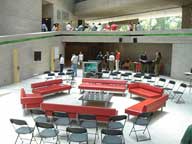 PART FOUR
PART FOUR
ORIGINAL POST: Monday, September 13, 2004
EXCERPT: Toward the beginning of the discussion I had expressed how glad I was to be part of an amazing set of events that were fully funded, something that was simply not possible in the United States at the moment due to the lack of funding following the extreme conservativism that has developed there since 9/11. And then, the relationship of Latin America to the United States was brought up in consideration to this dynamic—and the conversation became a bit heated. I explained that, unfortunately, no matter how great things, similar to the events happening around Centro + Media were, that the art culture in the United States, even today, has the tendency to ignore such events, and that this is a left over of the myth of the United States being the "center of the artworld." I emphasized how this was a problematic myth, particularly because the U.S. does not have the type of funding available to convene so many artists together for eight days at a five star hotel with all expenses paid and on top of this include a decent honorarium, especially in relation to new media, like Arcangel and Ivan had been able to do with great ease in Mexico City. Antonio Mendoza also added that he did not see events like this happening in the United States. Erandy responded explaining how Mexico and Latin America have the agency to write their own history and that there should be strategic efforts to make this a priority, and that she, personally,in the end, was not concerned how the United States viewed what was happening in Mexico.
click here to read the fourth installment.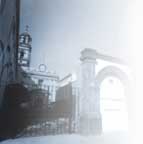 PART FIVE
PART FIVE
ORIGINAL POST: Monday, October 04, 2004
EXCERPT: Media’s tendency is to overwhelm the senses. The exhibitions at Centro and Laboratorio Arte Alameda lived up to this particular expectation with great ease. And because of this, the aesthetics of the performances and installations could be dangerously universalized. Part of the reason lies in the fact that the tools used by the performers and artists are the products and vehicles of globalization, which strategically saturate the senses to create the necessary desire to keep production and consumption at its peak. Another reason is the fact that, thanks to the same tools, people, who can afford to use them, can communicate across continents not worrying too much about their geographical places, thus leading to an international activity that seemly transcends the usual cartographic codes through which cultures have in the not so distant past negotiated their ever-changing ways of living.
One could notice this by simply listing the actual equipment and software: Mac G5 powerbooks were the most common computers in use by many of the performers, and Sony Vaios were the standard for most installations; for development, Flash, Director and Max/Jitter were often the applications of choice. And then, once in front of a screen, whether this one was a projection or a computer monitor, the viewer could easily fall into a state of placelessness. Suspense of disbelief never had a better home.
click here to read the fifth installment.